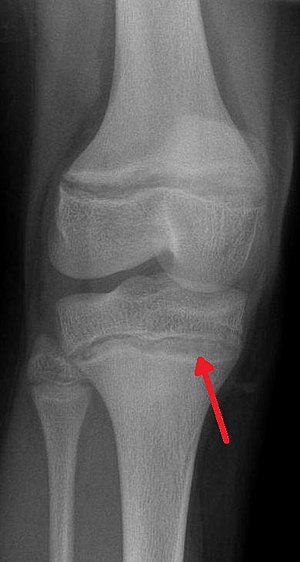Lead poisoning
| Lead poisoning | |
|---|---|
| Synonyms | plumbism, colica pictorum, saturnism, Devon colic, painter's colic |
 |
|
| An X ray demonstrating the characteristic finding of lead poisoning in humans—dense metaphyseal lines. | |
| Classification and external resources | |
| Specialty | Toxicology |
| ICD-10 | T56.0 |
| ICD-9-CM | 984.9 |
| DiseasesDB | 7307 |
| MedlinePlus | 002473 |
| eMedicine | article/815399 |
| Patient UK | Lead poisoning |
| MeSH | D007855 |
Lead poisoning is a type of metal poisoning caused by lead in the body. The brain is the most sensitive. Symptoms may include abdominal pain, constipation, headaches, irritability, memory problems, inability to have children, and tingling in the hands and feet. It causes almost 10% of intellectual disability of otherwise unknown cause and can result in behavioral problems. Some of the effects are permanent. In severe cases anemia, seizures, coma, or death may occur.
Exposure to lead can occur by contaminated air, water, dust, food, or consumer products. Children are at greater risk as they are more likely to put objects in their mouth such as those that contain lead paint and absorb a greater proportion of the lead that they eat. Exposure at work is a common cause of lead poisoning in adults with certain occupations at particular risk. Diagnosis is typically by measurement of the blood lead level. The Centers for Disease Control (US) has set the upper limit for blood lead for adults at 10 µg/dl (10 µg/100 g) and for children at 5 µg/dl. Elevated lead may also be detected by changes in red blood cells or dense lines in the bones of children as seen on X-ray.
Lead poisoning is preventable. This includes by individual efforts such as removing lead-containing items from the home, workplace efforts such as improved ventilation and monitoring, and nationwide policies such as laws that ban lead in products such as paint and gasoline, reduce allowable levels in water or soil, and provide for cleanup of contaminated soil. The major treatments are removal of the source of lead and the use of medications that bind lead so it can be eliminated from the body, known as chelation therapy. Chelation therapy in children is recommended when blood levels are greater than 40-45 ug/dl. Medications used include dimercaprol, edetate calcium disodium, and succimer.
...
Wikipedia
